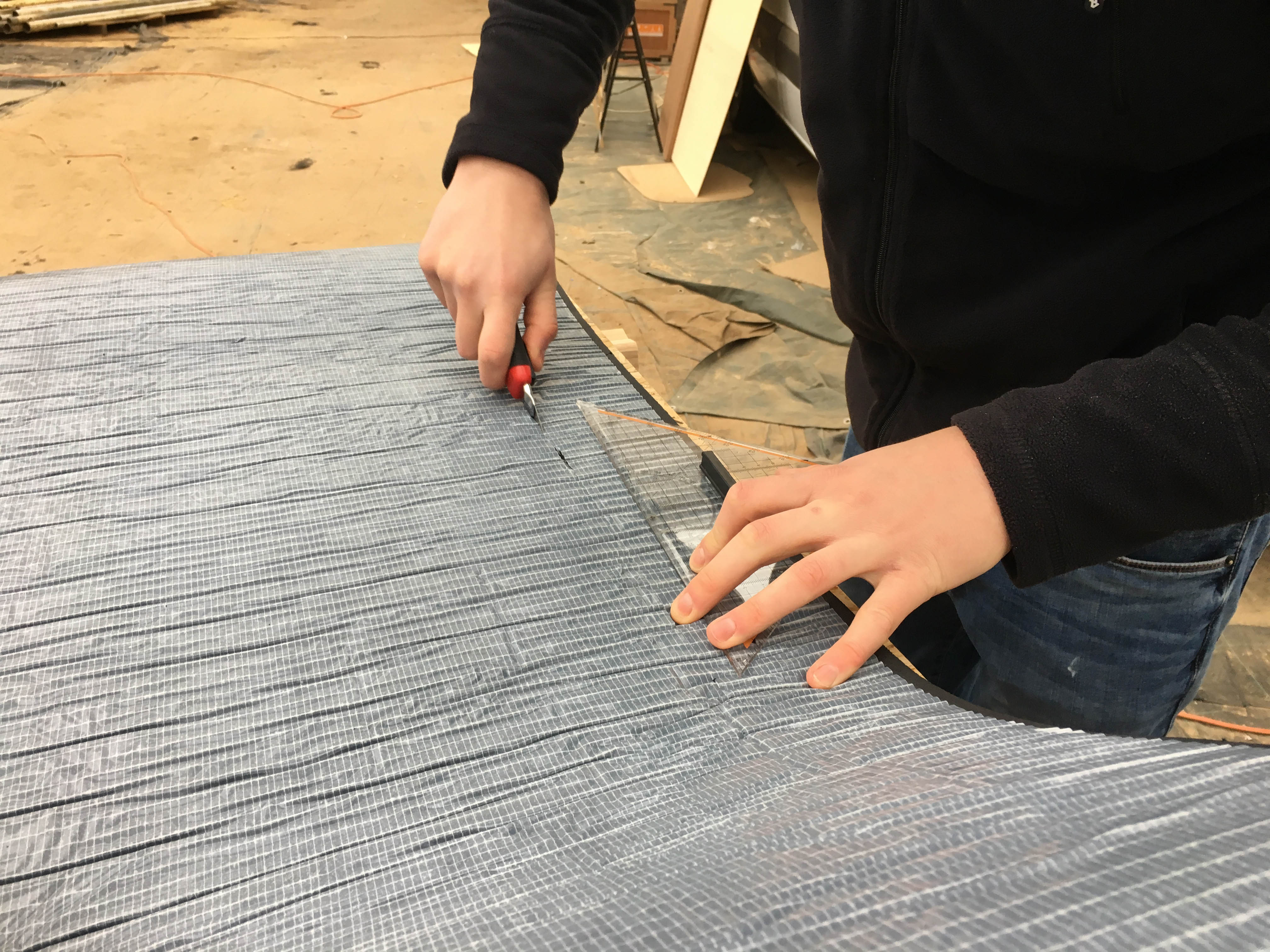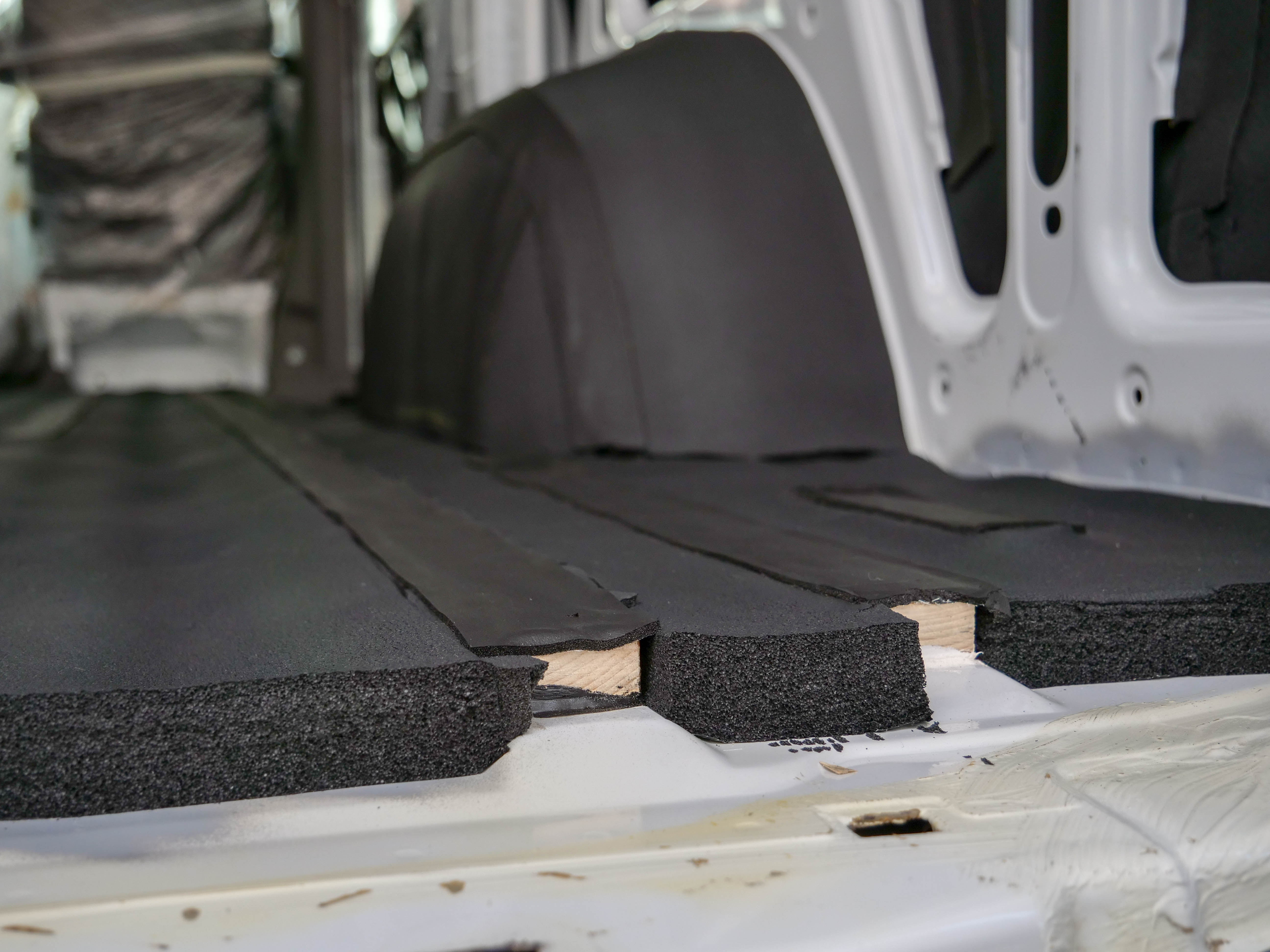Thermal insulation for great room climate in the Sprinter Campervan no matter how hot or cold it is outside! We tell you about our practical experiences working with Armaflex and show you some alternatives when it comes to thermal insulation.
To say it up front – with all of its nooks, edges and hollow spaces, the Sprinter is quite ungrateful.
With a craft-knife and a preferably new and sharp blade the Armalfex is easy to cut. The glue of the self-adhesive back holds very good onto the grease free surfaces (maybe even a little too good). The big surfaces of the side walls and the floor as well of the ceiling are quickly measured, cut and adhered with Armaflex 25 mm.
The thinner the material, the more flexible the mats. That’s why we chose to use Armaflex 19 mm for the wheel cases because it’s easier to put around the curvature. This also applies for the ceiling of the driver’s cab. Across the bars we will later be using Armaflex 6 mm but only after we add the supporting wooden struts for the furniture which we will rivet into the metal so we won’t have to screw and rivet through the insulation.

We sealed the hems of the mats as well as the wooden slats on the floor with Armaflex-Tape which is only 3 mm thick.
Now the biggest problem with the Sprinter is the following: As easy as it is to work with the big surfaces and parts, as hard it is to work with the small, angled, hard to reach surfaces behind and in between the bars, the doors, especially the sliding door where you have to watch the cables at all times! All the way up to our elbows, our arms were crammed into it to reach every last corner, the sharp edges cut our arms – there was los of swearing. But now we’re sure we insulated „everything“ with Armafex as good as possible.

We’re really glad this step is over and we’re pretty sure we won’t ever do this again! Ever.
Our tip (for the next time, anyways): It might be easier to use the non-self-adhesive Armaflex for the spots that are hard to reach such as behind the bars and any other hollow spaces. Maybe it works better to apply the glue to the spot and then fiddle the Armaflex onto it rather than also sticking to it yourself all the time 😉 because then also removing the foil of the self-adhesive back of the Armaflex is very time consuming and you might spare yourself some nerves.

ALTERNATIVE: X-Trem Isolator
An alternative material made of caoutchouc is X-Trem Isolator with similar characteristics as well as pros and cons as the Armaflex. The mats are also available online with a self-adhesive or non-self-adhesive back.
Our research has shown though, that the processing is supposed to be a little harder and the mats can not be adjusted to the different grounds quite as easily. Therefore and due to the higher price we did not chose X-Trem Isolator.
Kosten
- Ø approx. 17,50 € / m² (depending on the thickness; the thinner, the cheaper
- Thickness 10 mm: ca. 15,00 € / m²
- Thickness 20 mm: ca. 20,00 € / m²
ALTERNATIVE: Mineral wool (e.g. glass or rock wool) or organic insulation made of natural materials (e.g. hemp or flax)
Pros
- Low weight
- Easy to process
- Can easily be stuffed into corners and hollow spaces
- Sustainability, the essential components are available in abundance e.g. sand, limestone and scrap glass are recycled; for the manufacturing of insulation mats made of hemp the stem of the plant is used
- Great price-performance ratio (performance as insulation in general)
Cons
- The wool is loose, which means it is shaking while driving and thus clumps are forming which means gaps in the insulation. In these cold gaps, moisture gathers which may lead to rust
- Because the material is open pored, it absorbs moist from the inside and therefore loses its insulating characteristics. Behind the wooden panels it can not dry off and the moisture may cause mold and (drowsy) smell
Price
- Rock wool with a thickness of 30 mm is available at approx. ca. 5,00 € / m² at the hardware store or online
- Hemp mats with a thickness of 30 mm are available at approx. 3,50 € / m² online
ALTERNATIVE: Expand polystyrene (EPS) or styrofoam
Pros
- Cheap
- Low weight and easy to process
- Does not lose its insulating characteristics even when damp. Styrofoam does not rot which is a big con when it comes to its disposal
Cons
- The production from fossil oil uses up much energy
- High flammability!
- Almost no flexibility which means the plates can not be adjusted to the curvature of the vehicle
- While moving or driving, the plates rub against each other as well as against the wood of the floor plate or the paneling which may cause squeaking noises – we don’t want that. Anyways, styrofoam is commonly used by campervan manufacturers
- Styrofoam shrinks over time so there might be cold spots between the plates
Price
- EPS plates with a thickness of 20 mm are available at the hardware store at approx. 2,00 € / m2 or online
Read more about campervan insulation basics. Also read about noise insulation with Alubutyl. and thermal insulation with Armaflex-AF, pros & cons as well as information about price and availability
